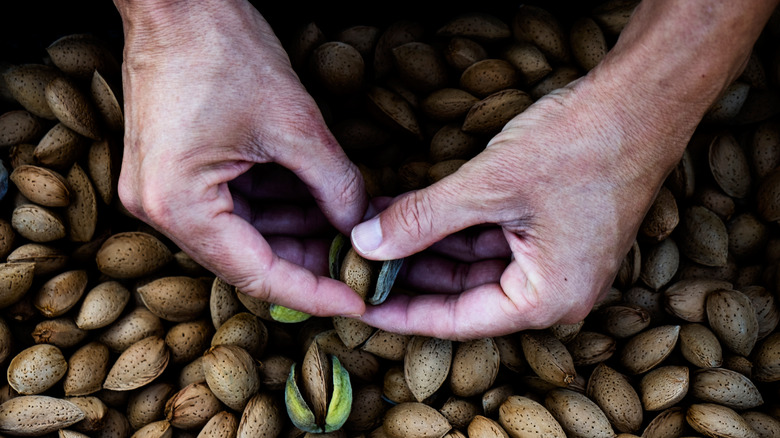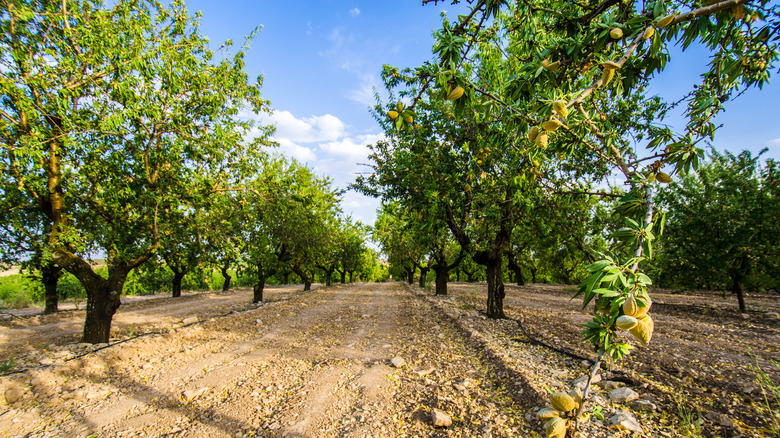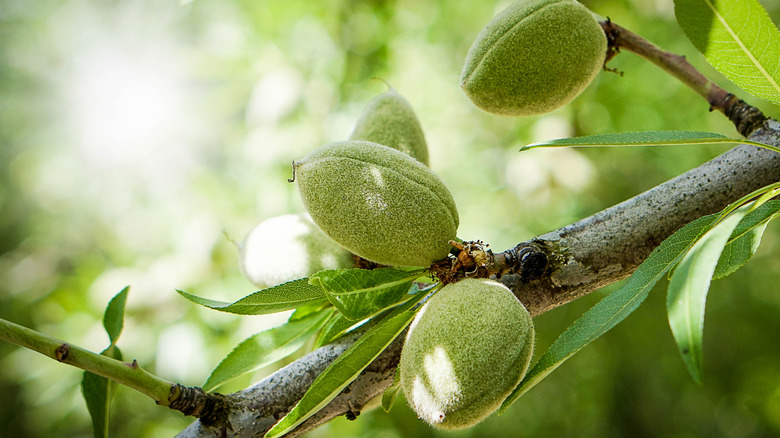The Absurd Amount Of Almonds California Might Be Stuck With
It's no secret that grocery prices have been on the rise in recent months. Inflation, high gas prices, a worker shortage in food-processing facilities, and supply chain problems exacerbated by the war in Ukraine are just some of the conditions contributing to rising costs (via NBC News).
Climate change is another major factor when it comes to high prices on grocery shelves. The record-breaking Po River Valley drought in Italy earlier last month knocked out an entire crop of tomatoes, grapes, rice, and grain (via Associated Press). And global warming has been devastating to crops in California's central valley, which is experiencing record drought that impact almonds, olive oil, citrus, grapes, and more, according to Forbes.
Global food accessibility has primarily been the result of shortages. Now, however, California almond farmers, which produce 82% of the world's almonds, are facing the exact opposite problem. As the Los Angeles Times notes, they're up to their eyeballs in almonds, but have no place to sell them.
More almonds than they know what to do with
This year, almond farmers are looking at a whopping 2.8 billion pound harvest — and that's on top of 2.9 billion pounds in 2021 and an all-time high of 3.1 billion pounds in 2020, according to the Los Angeles Times. This might sound like good news, but, in reality, it isn't. While production is high, exports are down 13% this year. Part of the problem, the Times explains, is that during COVID, shipping companies realized they could make more trips and more money by sending their empty vessels back to Asia, where they could be filled up with more products, rather than sitting in California ports waiting for almonds to be loaded onto ships. "It's all about money," almond producer David Phippen told the Times. "After years of prospering together, foreign shipping vessels have decided to stop servicing us."
Blue Diamond reported a total 17% decline in almond shipments from the previous season. As Blue Diamond Vice President Laura Gerhard explained in the company's 2022 Market Update, "Vessel logistics continue to complicate execution and impact traditional shipment patterns and cadence leading to the fourth consecutive month of declines for export markets."
As a result, California's almond production is now exceeding export demands — by a lot. According to the LA Times, 1.3 billion pounds of almonds are currently sitting — unsold — in California storehouses.
Fighting climate change in the meantime
Adding to the problem is the severe drought in California. According to the U.S. Drought Monitor (USDM), a real-time map of drought across America updated with new data weekly, 97.5% of California is currently experiencing "Severe Drought," 59.8% is experiencing "Extreme Drought," and 11.6% is experiencing "Exceptional Drought" — the highest category of drought on the monitor. When you consider that a single almond requires 1.1 gallons of water to grow, according to Mother Jones, it's a recipe for disaster.
Luckily, the almond industry has recently been making a push toward sustainability, reportedly cutting water usage by 33%, according to the Almond Board of California, with plans to reach a total 53% reduction by the year 2025. This effort might not solve the current shipping problem, but it will likely make a big difference for California's drought-stricken soil. Hopefully, more sustainable farming practices and a shift in global distribution trends will soon relieve California of its massive almond surplus.


